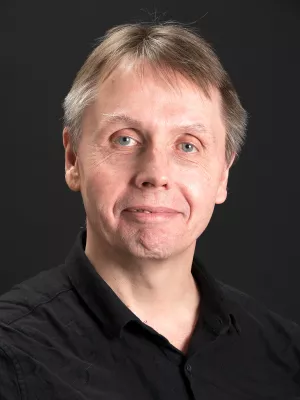
Michael Edgerton
Professor

1 sonata (e70), for piano
Other contributions
- Michael Edgerton
Summary, in English
Albert-László Barabási, from the introduction to his book titled Linked: the new science of networks, “Just as diverse humans share skeletons that are almost indistinguishable, we have learned that these diverse maps follow a common blueprint. A string of recent breathtaking discoveries has forced us to acknowledge that amazingly simple and far-reaching natural laws govern the structure and evolution of all the complex networks that surround us.” (Barabási, 2003)
In part, this 1 sonata is influenced by a line of work known as “scale-free” networks. Briefly what this suggests is that networks are everywhere, from biological to eco-systems, even to the internet. These are not yet well understood, but research is beginning to provide answers. It seems that many networks are dominated by a relatively small number of important nodes/hubs that are connected to many other sites. While some hubs have only a few links, others have an enormous amount of links, and it is this sense in which they are “scale-free”. Further, no node is typical of the others.
This is dramatically different than the previous 40 years of research on complex networks, which were understood to be random, such that most nodes have approximately the same number of links. What recent research had found was that, instead of following a bell-shaped distribution (like the height of the majority of the world’s population), many networks feature a power law distribution (or finding the equivalent of lots of folks who are100 feet tall!).
These answers have significantly altered our understanding of complex networks. Unexplained by previous network theories, hubs offer convincing proof that various complex systems have strict architecture ruled by fundamental laws – these laws apply to real-world systems (cells, computers, languages and society) – but further, these organizing principles have significant implications for creation (developing better drugs, defending the internet, halting the spread of epidemics, or even composing music).
In part, this 1 sonata is influenced by a line of work known as “scale-free” networks. Briefly what this suggests is that networks are everywhere, from biological to eco-systems, even to the internet. These are not yet well understood, but research is beginning to provide answers. It seems that many networks are dominated by a relatively small number of important nodes/hubs that are connected to many other sites. While some hubs have only a few links, others have an enormous amount of links, and it is this sense in which they are “scale-free”. Further, no node is typical of the others.
This is dramatically different than the previous 40 years of research on complex networks, which were understood to be random, such that most nodes have approximately the same number of links. What recent research had found was that, instead of following a bell-shaped distribution (like the height of the majority of the world’s population), many networks feature a power law distribution (or finding the equivalent of lots of folks who are100 feet tall!).
These answers have significantly altered our understanding of complex networks. Unexplained by previous network theories, hubs offer convincing proof that various complex systems have strict architecture ruled by fundamental laws – these laws apply to real-world systems (cells, computers, languages and society) – but further, these organizing principles have significant implications for creation (developing better drugs, defending the internet, halting the spread of epidemics, or even composing music).
Department/s
- Teachers (Malmö Academy of Music)
Publishing year
2004
Language
English
Links
Document type
Artistic work
Publisher
BABELSCORES®
Topic
- Music
Status
Published